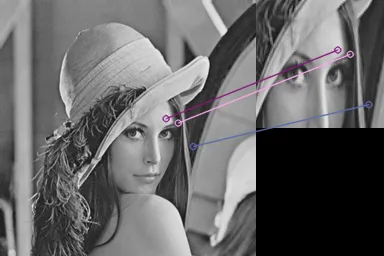我有一张示例图片:

使用以下变换矩阵对图片进行仿射变换:
[[ 1.25 0. -128 ]
[ 0. 2. -192 ]]
并从结果中裁剪出一个128x128的部分以获得输出图像:

现在,我想通过仅比较示例和输出图像来估计变形矩阵和裁剪大小/位置。 我使用SURF检测特征点,并通过暴力匹配它们:

有许多匹配,我保留了最佳的三个(按距离),因为这是估算仿射变换所需的数量。 然后,我使用这3个关键点使用getAffineTransform估计仿射变换。 但是,它返回的转换完全错误:
-0.00 1.87 -6959230028596648489132997794229911552.00
0.00 -1.76 -0.00
我在做什么不对吗?下面是源代码。
执行仿射变换(Python):
"""Apply an affine transform to an image."""
import cv
import sys
import numpy as np
if len(sys.argv) != 10:
print "usage: %s in.png out.png x1 y1 width height sx sy flip" % __file__
sys.exit(-1)
source = cv.LoadImage(sys.argv[1])
x1, y1, width, height, sx, sy, flip = map(float, sys.argv[3:])
X, Y = cv.GetSize(source)
Xn, Yn = int(sx*(X-1)), int(sy*(Y-1))
if flip:
arr = np.array([[-sx, 0, sx*(X-1)-x1], [0, sy, -y1]])
else:
arr = np.array([[sx, 0, -x1], [0, sy, -y1]])
print arr
warp = cv.fromarray(arr)
cv.ShowImage("source", source)
dest = cv.CreateImage((Xn, Yn), source.depth, source.nChannels)
cv.WarpAffine(source, dest, warp)
cv.SetImageROI(dest, (0, 0, int(width), int(height)))
cv.ShowImage("dest", dest)
cv.SaveImage(sys.argv[2], dest)
cv.WaitKey(0)
从两个图像中估算仿射变换(C++):
#include <stdio.h>
#include <iostream>
#include <opencv2/core/core.hpp>
#include <opencv2/features2d/features2d.hpp>
#include <opencv2/calib3d/calib3d.hpp>
#include <opencv2/highgui/highgui.hpp>
#include <opencv2/nonfree/nonfree.hpp>
#include <opencv2/imgproc/imgproc.hpp>
#include <algorithm>
using namespace cv;
void readme();
bool cmpfun(DMatch a, DMatch b) { return a.distance < b.distance; }
/** @function main */
int main( int argc, char** argv )
{
if( argc != 3 )
{
return -1;
}
Mat img_1 = imread( argv[1], CV_LOAD_IMAGE_GRAYSCALE );
Mat img_2 = imread( argv[2], CV_LOAD_IMAGE_GRAYSCALE );
if( !img_1.data || !img_2.data )
{
return -1;
}
//-- Step 1: Detect the keypoints using SURF Detector
int minHessian = 400;
SurfFeatureDetector detector( minHessian );
std::vector<KeyPoint> keypoints_1, keypoints_2;
detector.detect( img_1, keypoints_1 );
detector.detect( img_2, keypoints_2 );
//-- Step 2: Calculate descriptors (feature vectors)
SurfDescriptorExtractor extractor;
Mat descriptors_1, descriptors_2;
extractor.compute( img_1, keypoints_1, descriptors_1 );
extractor.compute( img_2, keypoints_2, descriptors_2 );
//-- Step 3: Matching descriptor vectors with a brute force matcher
BFMatcher matcher(NORM_L2, false);
std::vector< DMatch > matches;
matcher.match( descriptors_1, descriptors_2, matches );
double max_dist = 0;
double min_dist = 100;
//-- Quick calculation of max and min distances between keypoints
for( int i = 0; i < descriptors_1.rows; i++ )
{ double dist = matches[i].distance;
if( dist < min_dist ) min_dist = dist;
if( dist > max_dist ) max_dist = dist;
}
printf("-- Max dist : %f \n", max_dist );
printf("-- Min dist : %f \n", min_dist );
//-- Draw only "good" matches (i.e. whose distance is less than 2*min_dist )
//-- PS.- radiusMatch can also be used here.
sort(matches.begin(), matches.end(), cmpfun);
std::vector< DMatch > good_matches;
vector<Point2f> match1, match2;
for (int i = 0; i < 3; ++i)
{
good_matches.push_back( matches[i]);
Point2f pt1 = keypoints_1[matches[i].queryIdx].pt;
Point2f pt2 = keypoints_2[matches[i].trainIdx].pt;
match1.push_back(pt1);
match2.push_back(pt2);
printf("%3d pt1: (%.2f, %.2f) pt2: (%.2f, %.2f)\n", i, pt1.x, pt1.y, pt2.x, pt2.y);
}
//-- Draw matches
Mat img_matches;
drawMatches( img_1, keypoints_1, img_2, keypoints_2, good_matches, img_matches,
Scalar::all(-1), Scalar::all(-1), vector<char>(), DrawMatchesFlags::NOT_DRAW_SINGLE_POINTS);
//-- Show detected matches
imshow("Matches", img_matches );
imwrite("matches.png", img_matches);
waitKey(0);
Mat fun = getAffineTransform(match1, match2);
for (int i = 0; i < fun.rows; ++i)
{
for (int j = 0; j < fun.cols; j++)
{
printf("%.2f ", fun.at<float>(i,j));
}
printf("\n");
}
return 0;
}
/** @function readme */
void readme()
{
std::cout << " Usage: ./SURF_descriptor <img1> <img2>" << std::endl;
}